We’re tired of seeing amazing devtool companies neglect their email marketing.
Sure, software engineers are a bright example of a “sensitive” audience. They smell sales from five miles away. They cherish a clean inbox, unsubscribing right and left.
But email marketing still works for developer tools. You can accomplish tangible business goals using email automation:
- Establish an emotional connection between your customers and your team
- Communicate product quality and industry leadership
- Convert free users into paying customers at a better rate
- Upsell users to higher plans
- Reduce the amount of support during onboarding
- Showcase hidden “delighter” features
- Get in touch with top-performing customers, at scale
- Get more word-of-mouth growth
Best of all, you can put this on autopilot — even “set-and-forget” — and scale these communications to thousands of new users as your SaaS company grows. This works wonders for high-volume models like freemium or open-source.
It’s all about the “how.”
How do you market to developers while keeping your face and customer loyalty? What emails can you send so that your users want to stay subscribed?
Let’s unpack the tactics in this guide.
Modern developer tools like Grafbase, Flightcontrol, SpinupWP, Honeybadger, Urlbox, and Multi are using Userlist for their marketing and lifecycle emails. Care to join and unlock the growth benefits of email marketing? Book your demo call.
Don’t wait for the muse. Apply this step-by-step method to write high-performing email campaigns in hours, not weeks.
Developers don’t want to be sold to. Or do they?
Yuliya Tikhokhod of Hyperskill looked at their team chat for specific things shared by developers. Among them she found:
- A product promo featuring Microsoft Clippy (shared memory, vintage chic)
- A 100-day AI challenge that started on a specific date (urgency, trending topic)
- A long-overdue platform update that apparently had problems (cool news, negative gossip)
- Private beta invites to a new browser (exclusive access)
As Yuliya says:
“There’s nothing new under the sun. Developers share stuff for the same old reasons — this is cool, this is exclusive, I need this right now.”
That’s why industry stereotypes shouldn’t prevent you from marketing to developers. The following is true for any audience:
- Everybody is perceptive to marketing.
- Nobody likes bad marketing.
Michael Ludden of Turso says:
“We say that developers are special, that they don’t want to be sold to. The fact is, nobody wants to be sold to.”
Moreover, you must borrow marketing tricks from other industries.
Benedicte Raae, a developer advocate who has been serving many brands with joyful streaming content, shares:
“It’s a misconception that developers cannot be sold to. Their favorite influencers follow the same marketing playbooks as lifestyle bloggers. Except dev-fluencers are 6-12 months behind. You want to learn new things? Follow the mommy bloggers. Mommy bloggers are the best.”
Key principles for marketing to developers
Be transparent, especially about the edge cases
Product marketers from other industries may sugar-coat and overpromise.
With engineers, you don’t have this luxury. They will investigate your edge cases and hold you accountable for any cover-up. The sauce is in the details, so talk about these details upfront.
Therefore:
- Never overpromise and underdeliver.
- Share the edge cases upfront.
Be quirky or even ugly
Sure, there are brands like Vercel or Stripe who thrive on shipping delightful polished things. But it’s much easier to stand out if you don’t follow the enterprise stylebook.
Do you know that YouTubers hold their microphones these days? (Thanks to Benedicte for sharing this video. Yes, it’s one hour long.)
You want to be like them. This can take different forms:
- Pick a mascot like PostHog’s hedgehog, Honeybadger’s — ahem — honeybadger, or PostgreSQL’s elephant
- Use quirky illustrations (check out this bestiary by Honeybadger)
- Send extra short or extra long emails
- Post unpolished videos
- Express edgy opinions
- Use edgy language
Help readers stay up to date
Technology is evolving at 10x speed these days. Your readers will appreciate it if you help them stay up to date. This is one of the key reasons why they want to stay subscribed.
In your emails, include:
- Your own product updates
- News from companies, individuals, and organizations/foundations (especially in open source)
- Security updates
- Community discussions
- Industry gossip
- Quality content from other sources
- Anything else that’s entertaining or helpful
Our CTO Benedikt highlights the importance of open source news:
“The open source aspect is a big one. Stripe’s developer newsletter always contains posts about open source libraries by the community.”
Share deep content
Generic articles are a dime a dozen (let’s not even start on the AI-generated content). Dig deeper, and you’ll find that very few sources publish “the good stuff.”
You want to be one of these sources.
This means investing in the hard, “meaty” things: relevant examples, good stories. Our favorite approach is to collect the material first. Gather your examples and stories, and then craft your narrative around it.
Respect their inbox
Technical audiences know precisely how email marketing works, and are great at spotting unsolicited subscriptions and noisy senders.
Unless a user is being actively onboarded or going through an educational course, your sending cadence should be every 2-4 weeks (or even less frequently). This means, roll up your updates into newsletters, and only use dedicated broadcasts to announce the most important features (this can take the form of individual launch emails, email sequences, or even “launch weeks”).
Josh Wood of Honeybadger shares:
“Developers don’t hate email. But they do hate repetitive, irrelevant, and/or uninteresting email. I think that’s an opportunity, because the bar is pretty low. We send a lot of onboarding emails (up to around 15 emails over a 30-day trial), but they’re segmented by trial activity so that if you’ve already completed an activity, you don’t get an email about it.”
Honeybadger also uses Userlist’s subscription preferences to help customers manage their topics instead of unsubscribing.
But don’t swing into the opposite direction of “no emails” — your customers do expect to hear from you.
Jonathan Markwell of Urlbox, a website screenshot API, shares:
“I appreciate it when they email me at least once per month. Often I’ll sign up to a free plan or trial in the hope that I’ll get a reminder about the service in a few months when I’m ready to use it.”
Give more context & remind them who you are
Last but not least: developers get loads of emails from different platforms. You want to give them more context, remind them the name of your product, and what problem it solves.
Jonathan Markwell shares his frustration as a developer and CTO at multiple companies over the last 20 years:
“Too many companies fail to give me a one sentence reminder of what the tool does in the emails they send. It’s an extra leap for me to go and try figuring it out from their website.”
Leverage the authority of individuals
This is true for all industries, but especially true for “authentic” engineering content. Michael Christofides, our customer success engineer, shares:
“In devtools it’s not just companies. Some of the best stuff comes from individuals.”
From my own experience: it was way easier to run my mailing list for UI Breakfast as a solo consultant in the past, compared to running a mailing list on behalf of Userlsit. Same effort brings better results if it comes from a human.
How can you leverage this principle for your devtools marketing?
- Leverage the authority of your founder (think Karri Saarinen of Linear and his social media presence)
- Leverage the authority of your dev rel person (or developer advocate), if you have one
- Partner up with influencers in your field
You’ll see the same principle in practice as companies use people’s names in the “from” field.
What goes into the “from” field?
Email is a powerful channel for creating direct conversations between the audience and your team. Michael of Turso says:
“I try to be that invisible hand that connects the customers with the CEO/CTO. I always sign with the name of the CEO/CTO, and try to match their voice and tone.”
These devtools follow the pattern:
- Supabase: “Ant Wilson”, “Ant from Supabase” (Co-Founder & CTO)
- PlanetScale: “Taylor Barnett” (Staff Developer Advocate), “Nick Van Wiggeren” (VP of Engineering)
- AppSignal: “Nuala from AppSignal” (Nuala Doyle, Customer Success)
Some brands prefer to keep it to just a brand name:
- Vercel: “Vercel”
- Linear: “Linear”
- Stripe: “Stripe”
For transactional emails, like notifications or password resets, nearly all brands default to their brand name (“Supabase”, etc).
Email formatting ideas for developer audience
Use plain-text emails
Plain-text emails are the new (or not so new?) hot thing. This doesn’t mean sending entirely flat emails in monospace font; you can still apply a bit of styling. The point is to keep your words front-and-center.
Tuple’s welcome email is super-simple, but it does the job well.
Subject: Planning to try a Tuple call?
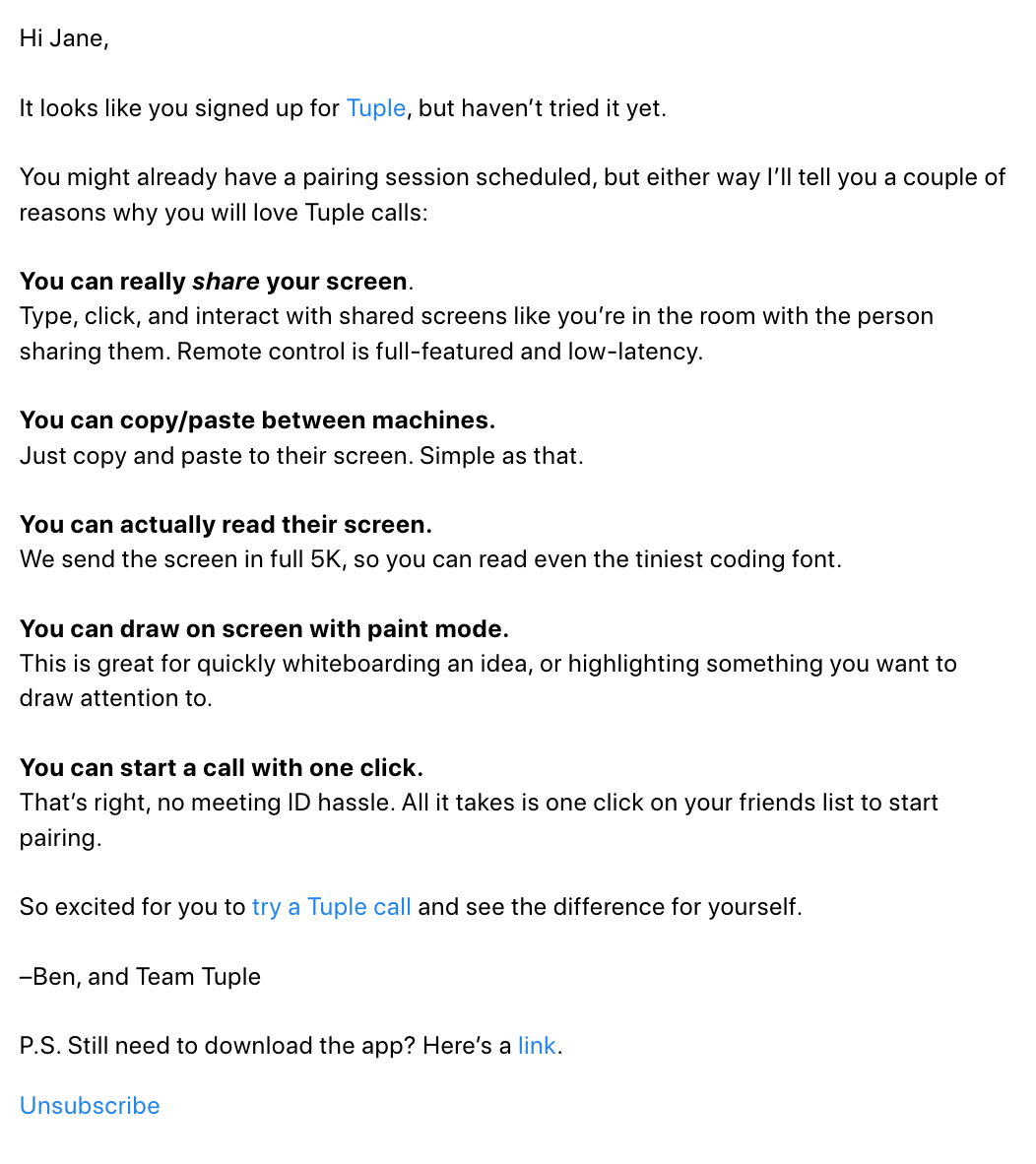
Use full links
Another thing we’ve noticed in developer emails: authors often prefer full-text links over anchor text or buttons. This shows off the beauty and the semantics of the URL, and gives you a heads-up on the final destination (as email marketing platforms redirect the links for click tracking).
Here’s AppSignal sharing links to their resources:

Linear displays a beautiful simple link to drive signups to their private beta:

Use diagrams to illustrate technical concepts
Sometimes screenshots are not enough to get your message across. For these special occasions, invest in diagrams.
In the example below, PlanetScale uses a diagram to showcase their non-blocking schema changes feature — one of their unique selling points.
Subject: Branch your database like your code

Include code snippets
When the context calls for it, don’t hesitate to include code snippets. In the example below, AppSignal shows how to run a report.
Subject: Step two: Install/debug AppSignal
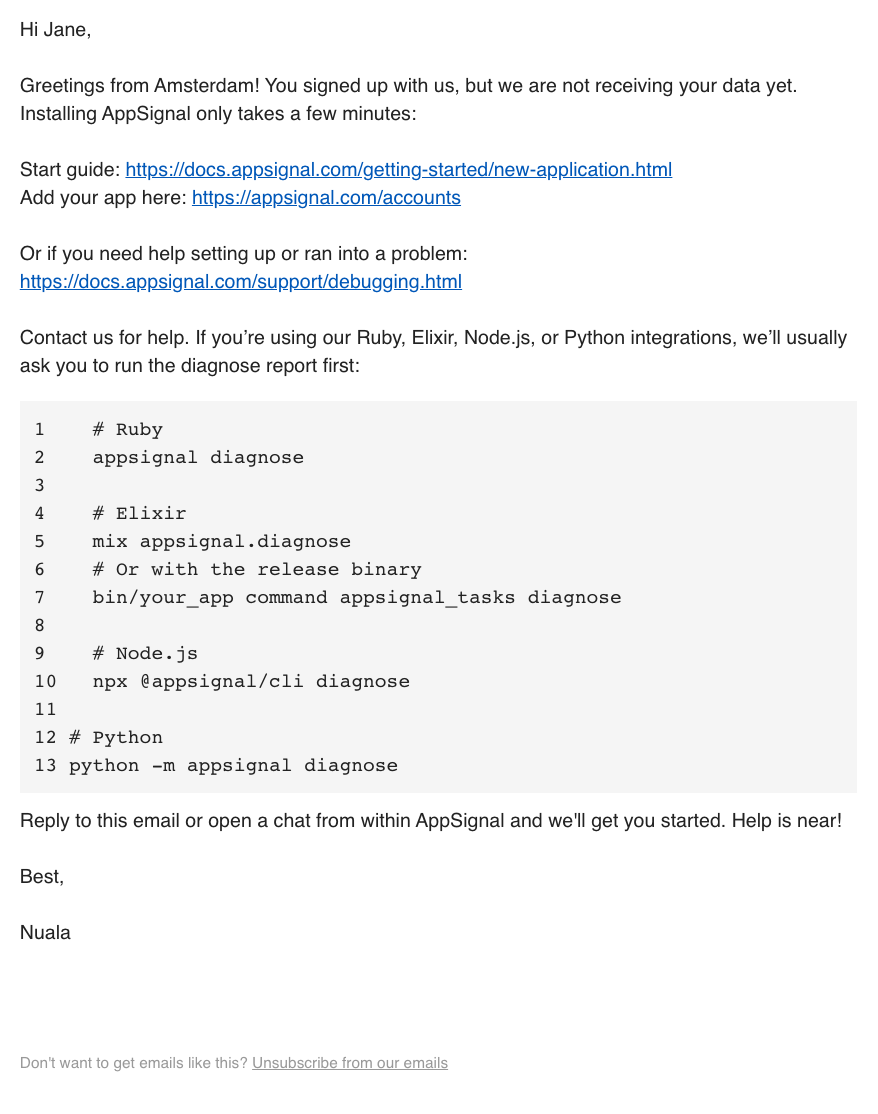
Or you can see how Stytch showcases their webhooks structure using a code snippet.
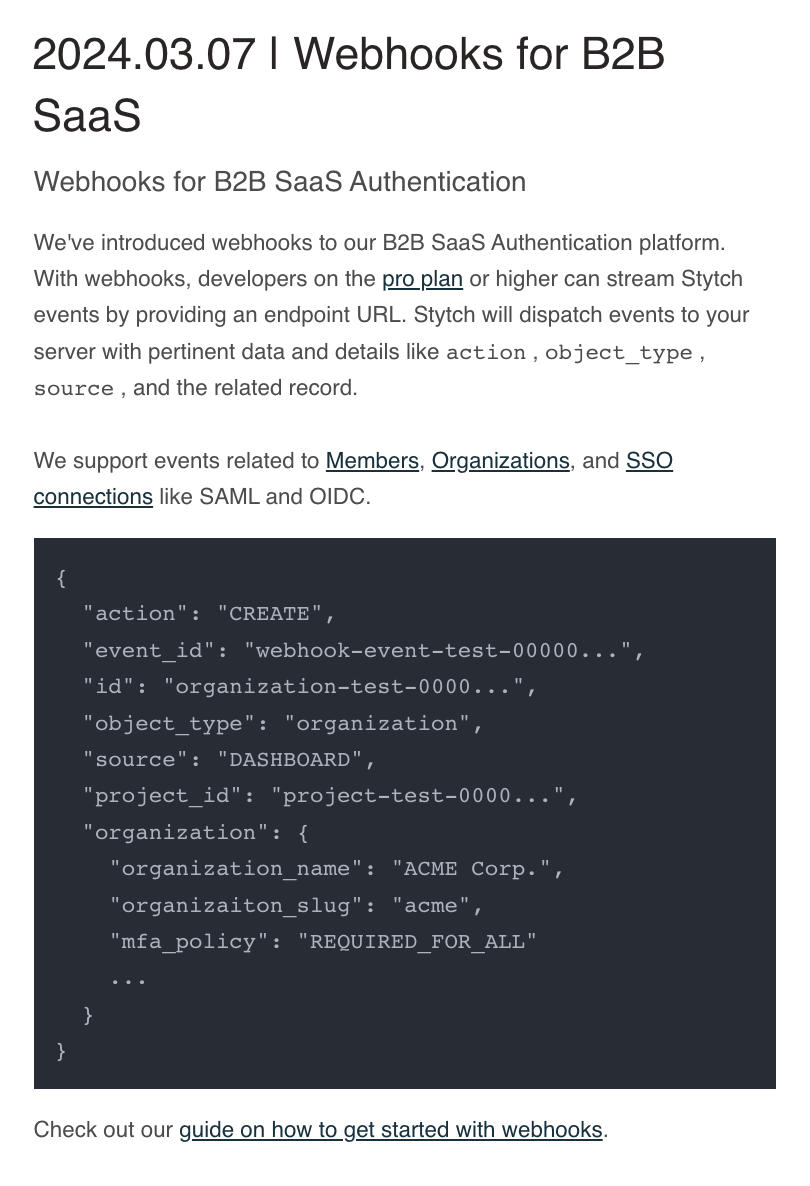
Share keyboard shortcuts
Email is perfect for letting your users know about hidden “delighter” capabilities of your platform — like keyboard shortcuts. You can use formatting to make these shortcuts stand out in the email body.
See this example from Linear:
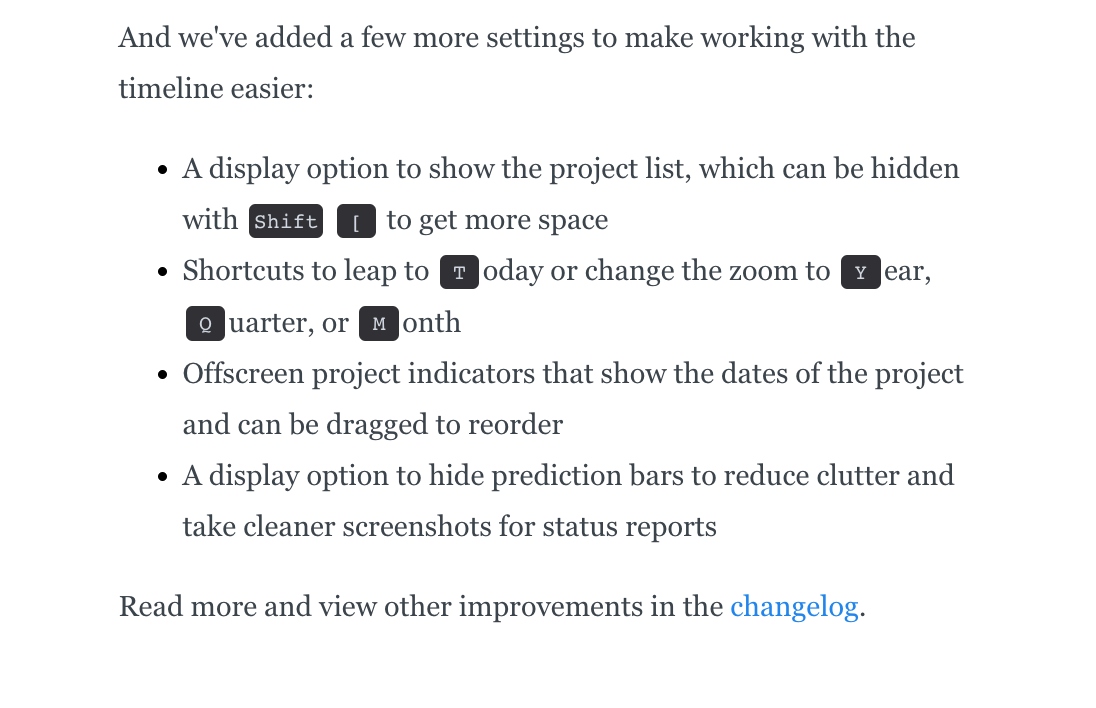
Don’t wait for the muse. Apply this step-by-step method to write high-performing email campaigns in hours, not weeks.
Do things for fun
Some things don’t serve a practical purpose but create moments of joy: quirky copy, an entertaining feature, or an easter egg. Try these things for an energy boost. Actually, it’s multiple boosts: one for your team as they’re creating it, and one for your users.
In the example below, the Linear team talks about their new emoji feature. Completely unnecessary, but charming.

When creating new accounts, Vercel provides you with a three-word security code. However, they put extra thought into architecting these phrases.
This particular combination made me smile:
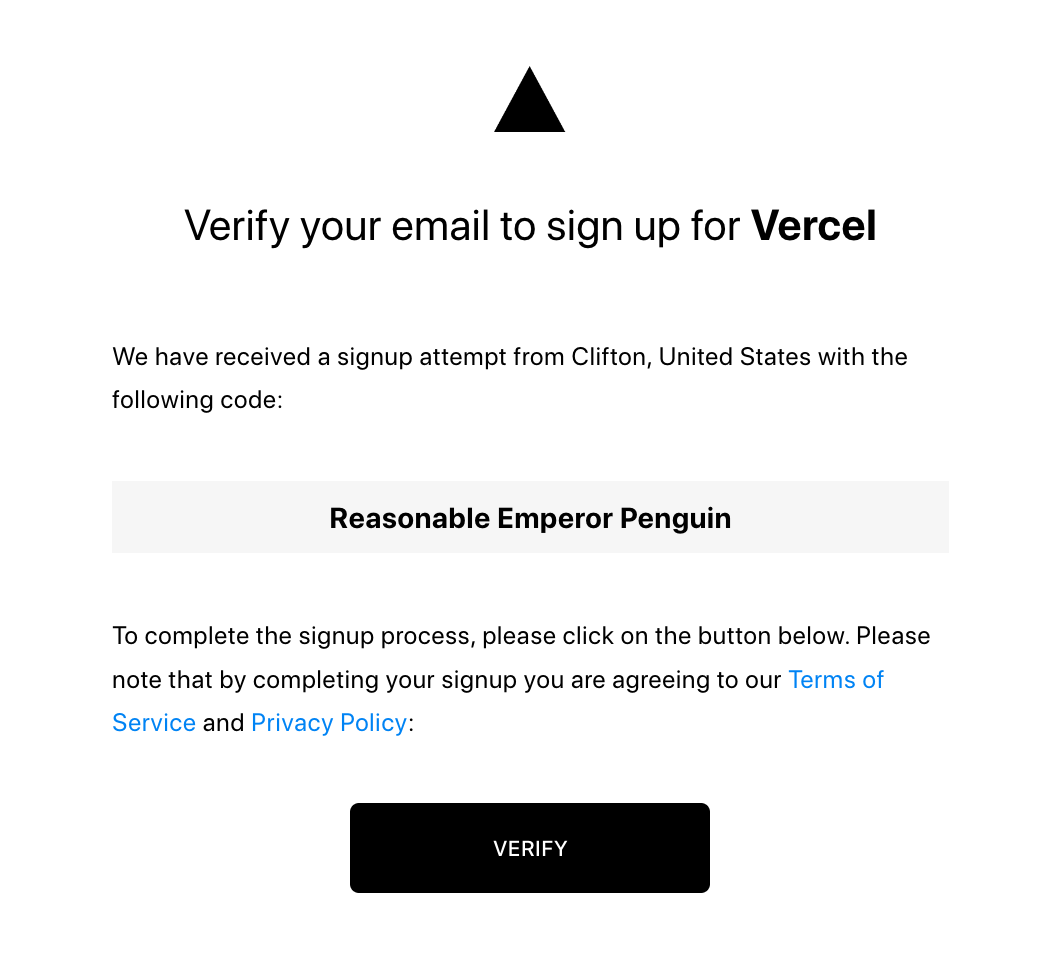
Newsletter is king. What makes a good one?
As we’ve mentioned above, you want to respect your reader’s inbox. Therefore, most of your content will go into your newsletters. First, let’s take a general look at how popular brands do theirs. Then we’ll look into individual components that comprise these newsletters.
Here’s what the newsletter from PlanetScale looks like.
Subject: 🚀 PlanetScale February newsletter

Supabase sends out a “Supa Update” every month.
Subject: Supa Update February 2024
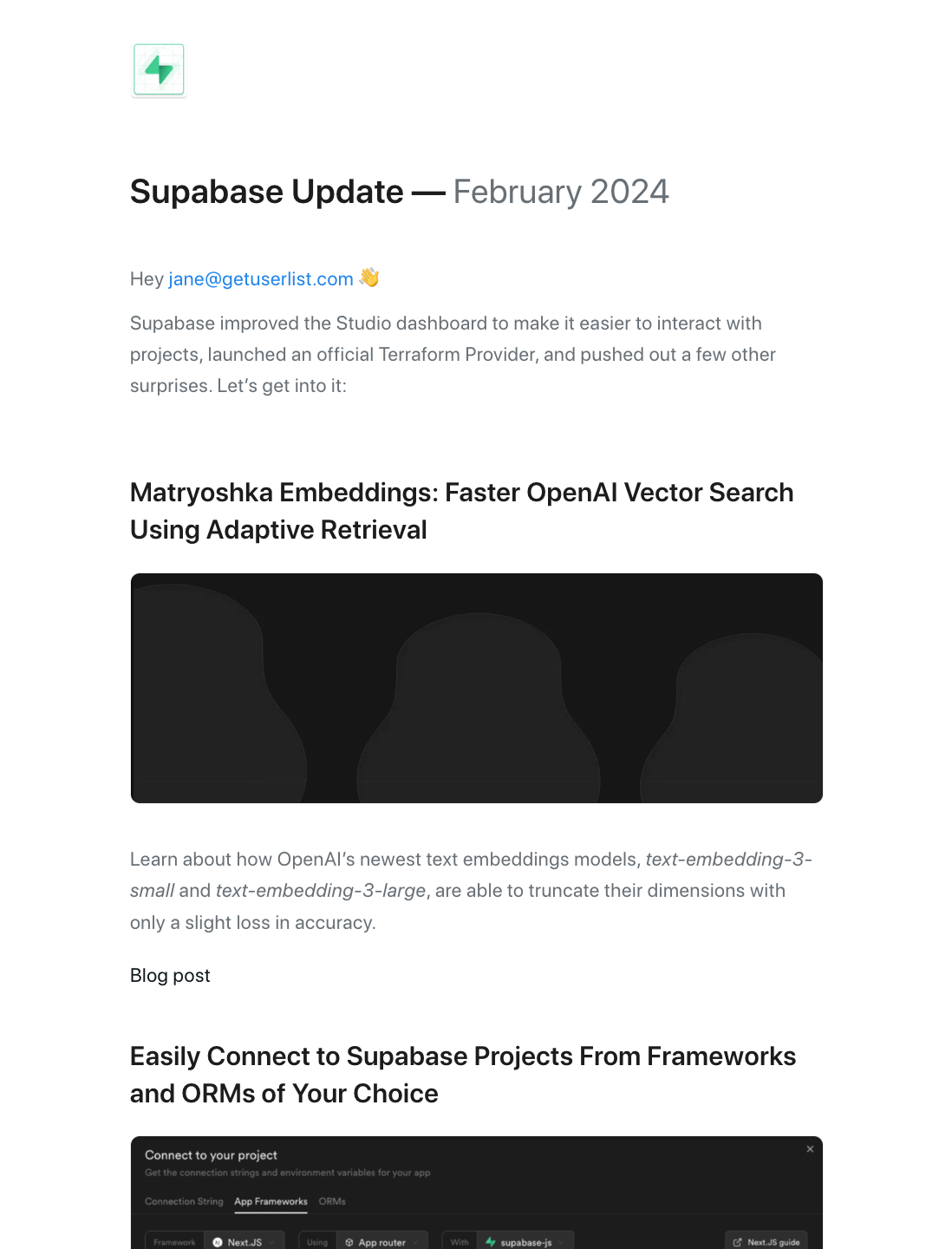
Vercel sends out a product newsletter every month, known for their crisp visual style.
Subject: Vercel February Product Update
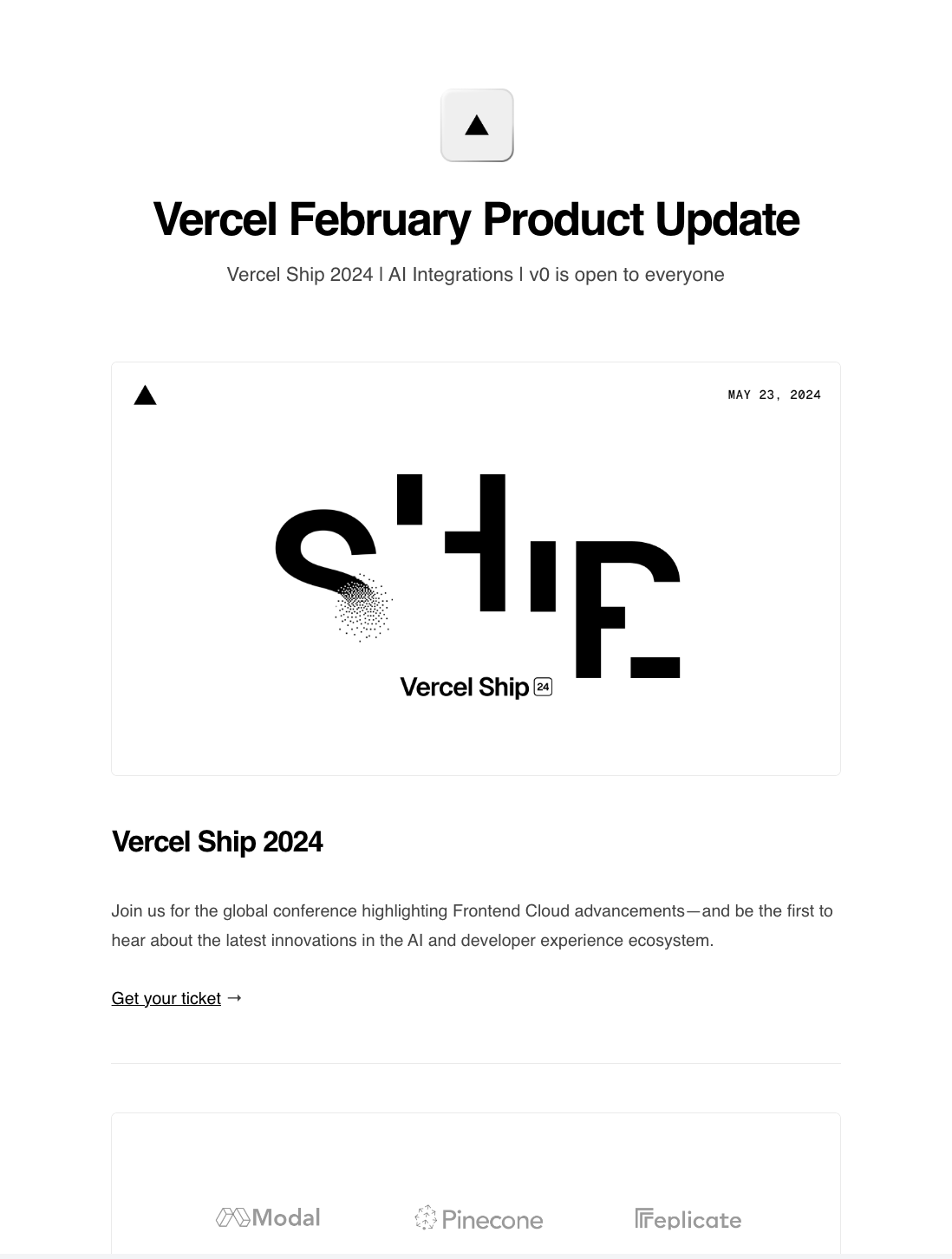
Now let’s dissect those newsletters into specific blocks. What sections can you include to provide maximum value so that your customers stay subscribed?
Blog highlights
If blog content is your jam, make sure to highlight your latest articles in the newsletter.
PlanetScale includes article titles and descriptions:
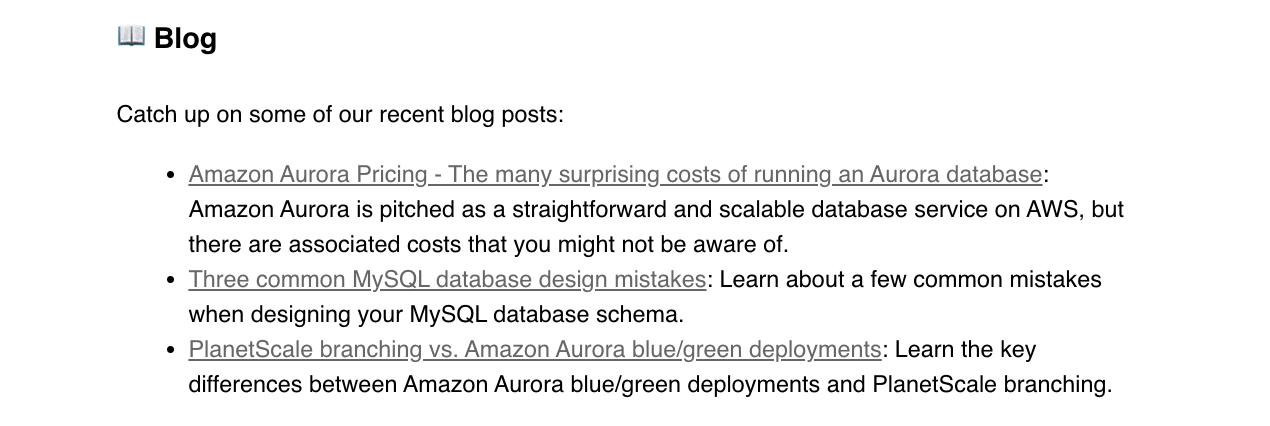
Vercel includes a simple bulleted list of their recent posts
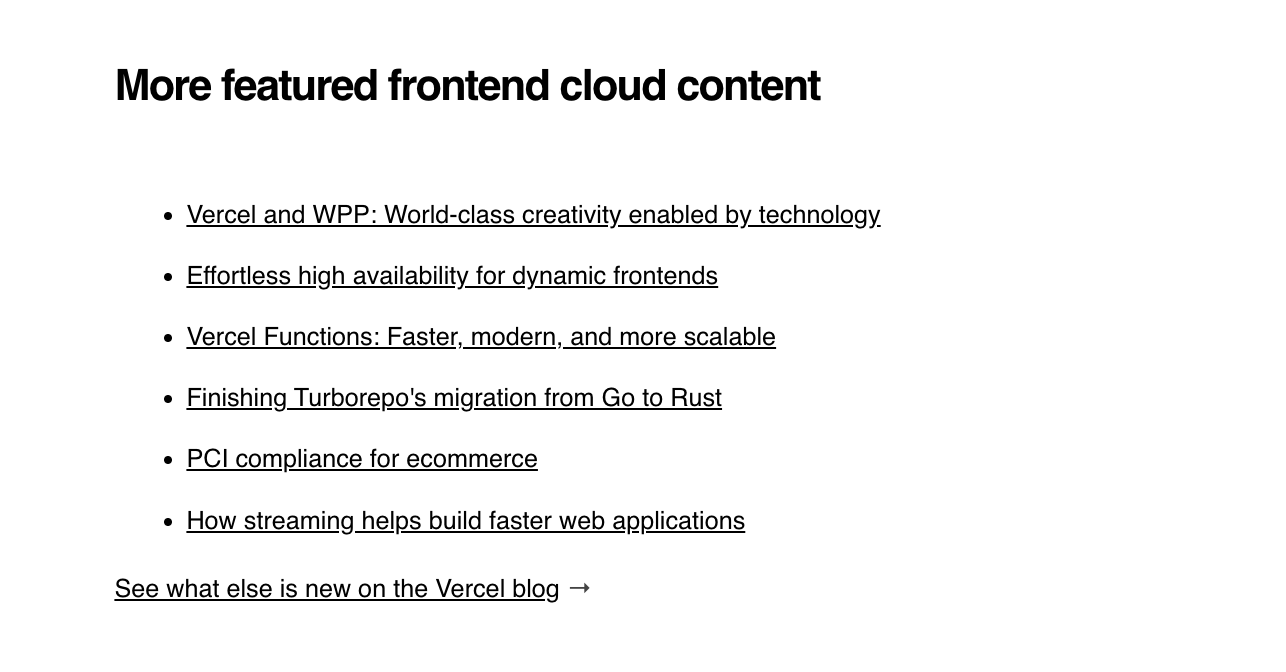
“Made with” section
“Made with” section is a powerful method to provide social proof, show your product in action, and employ FOMO — all at the same time. (If we talk about other industries, Figma is known for doing it for designers.)
Here’s how Supabase does it:
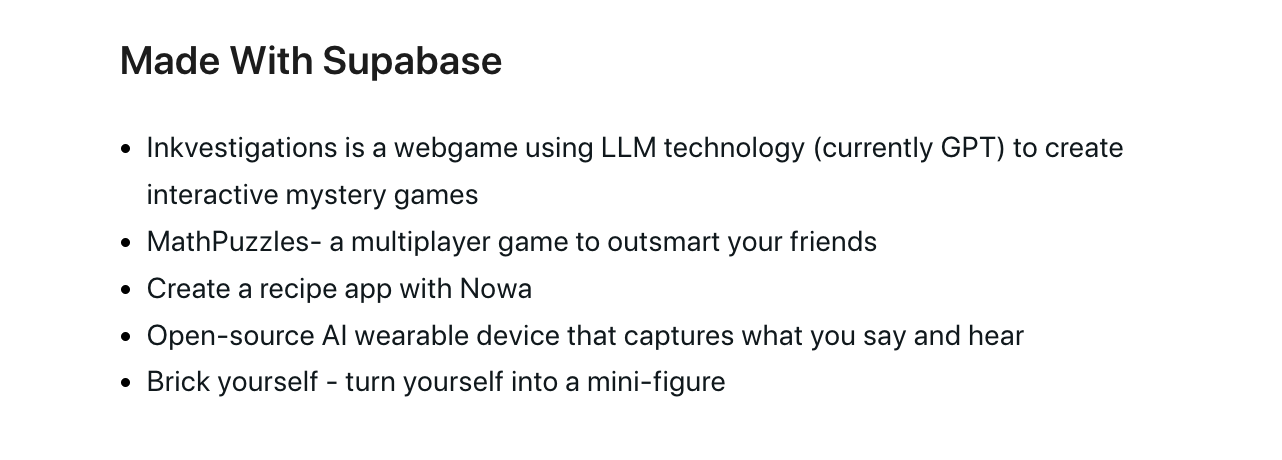
Industry news and reports
Stytch

Netlify shares their massive “State of Web Development” report with their mailing list.
If you want to do a report like that for your company, listen to this interview with Becky Lawlor on survey-based research projects. Such projects are a great way to create industry authority and build organic links.
Subject: New dev report, features, and integrations
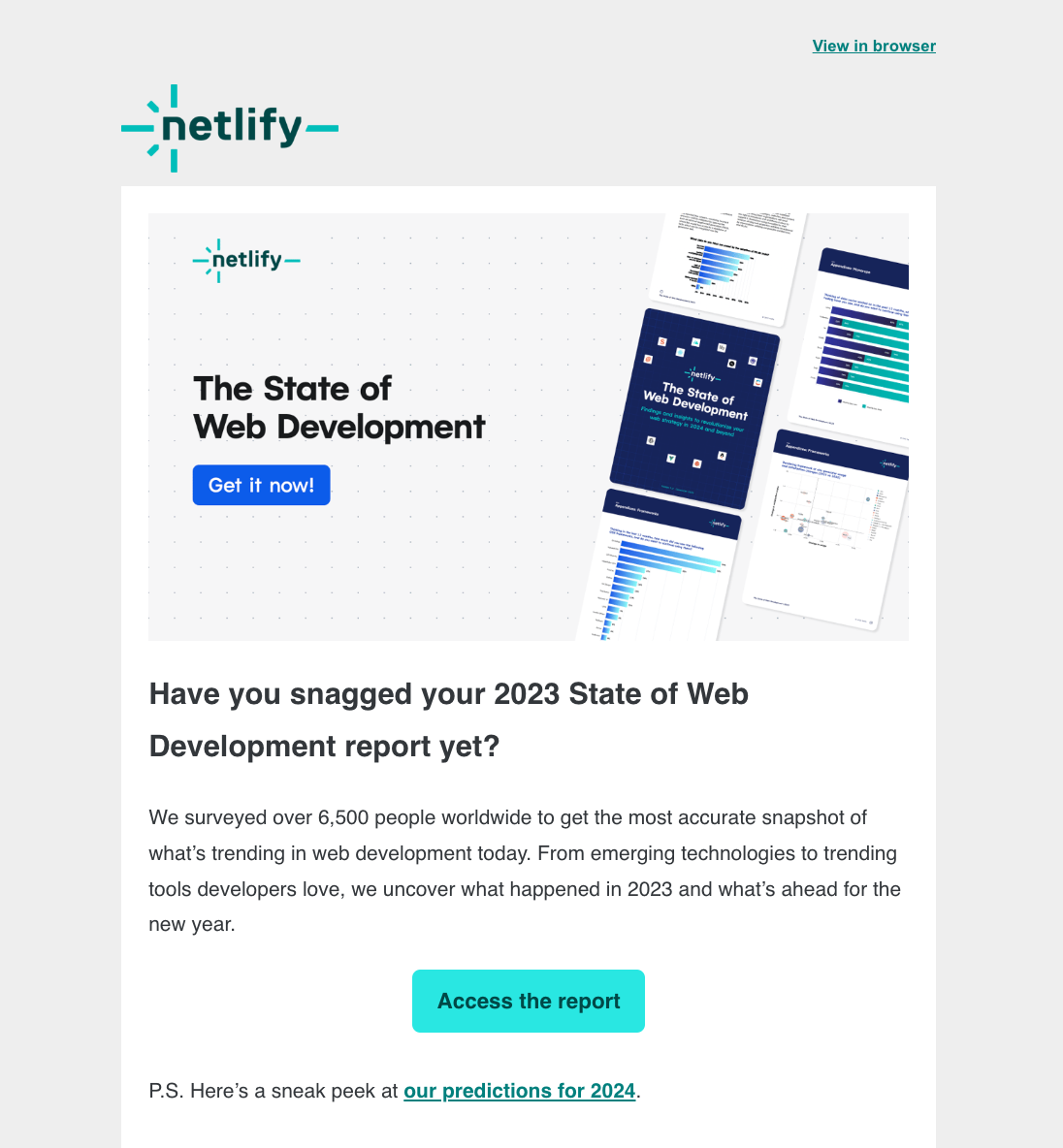
Educational resources
Investing in courses or training materials like courses, workshops, and webinars? Make sure to highlight them in your newsletters.
Here’s how PlanetScale promotes their Database Scaling course.
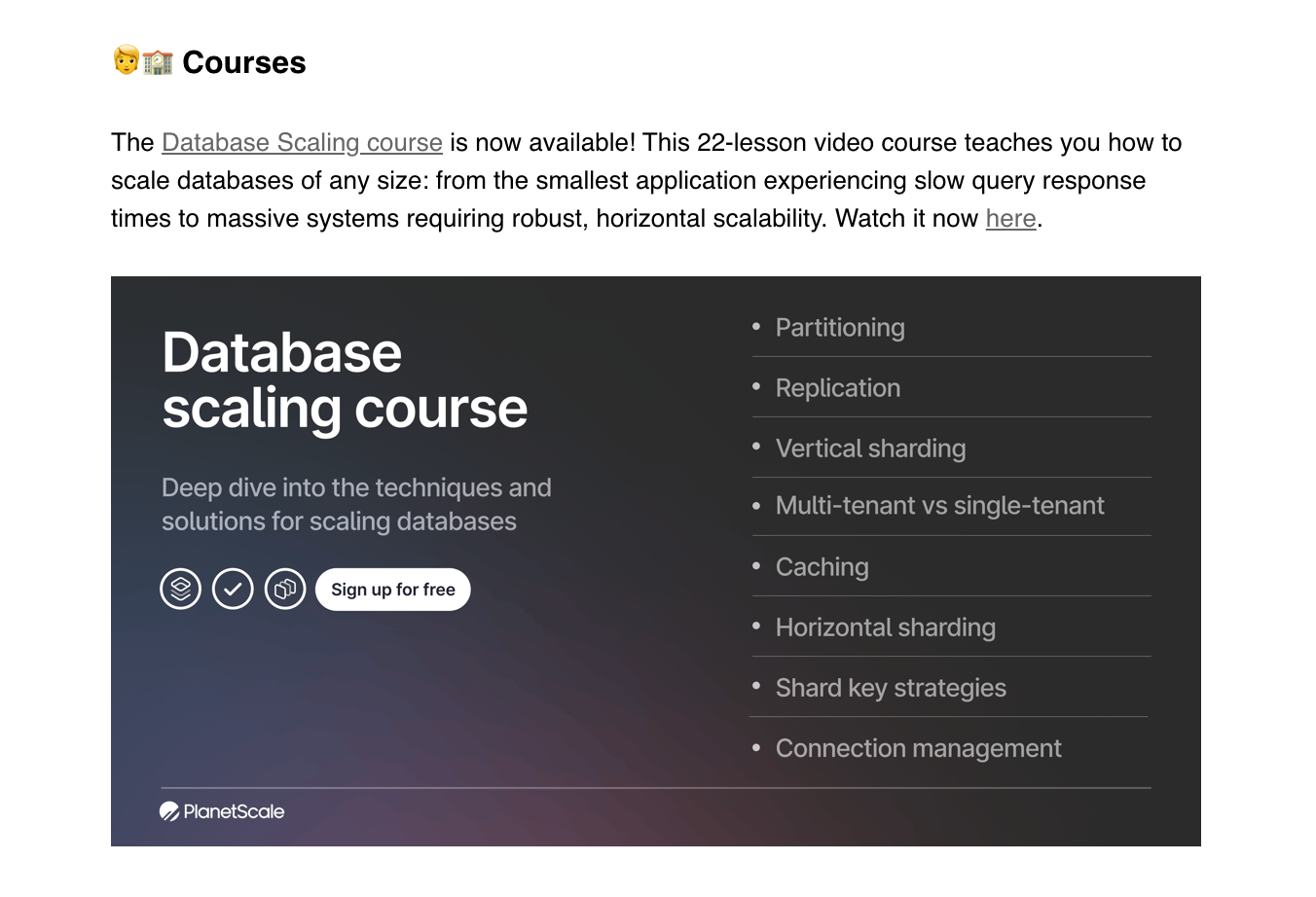
Videos and podcasts
Many devtool brands are investing in high-quality media content like podcasts or videos. You can include them in your newsletters, or send out new episodes as individual emails.
If you send out regular emails with new episodes, make sure to use subscription preferences so that readers can unsubscribe from this topic.
Here’s PlanetScale featuring their latest videos.

Community highlights
This is another way of building the spirit for your brand.
Supabase dedicates a section of their newsletter to community highlights:
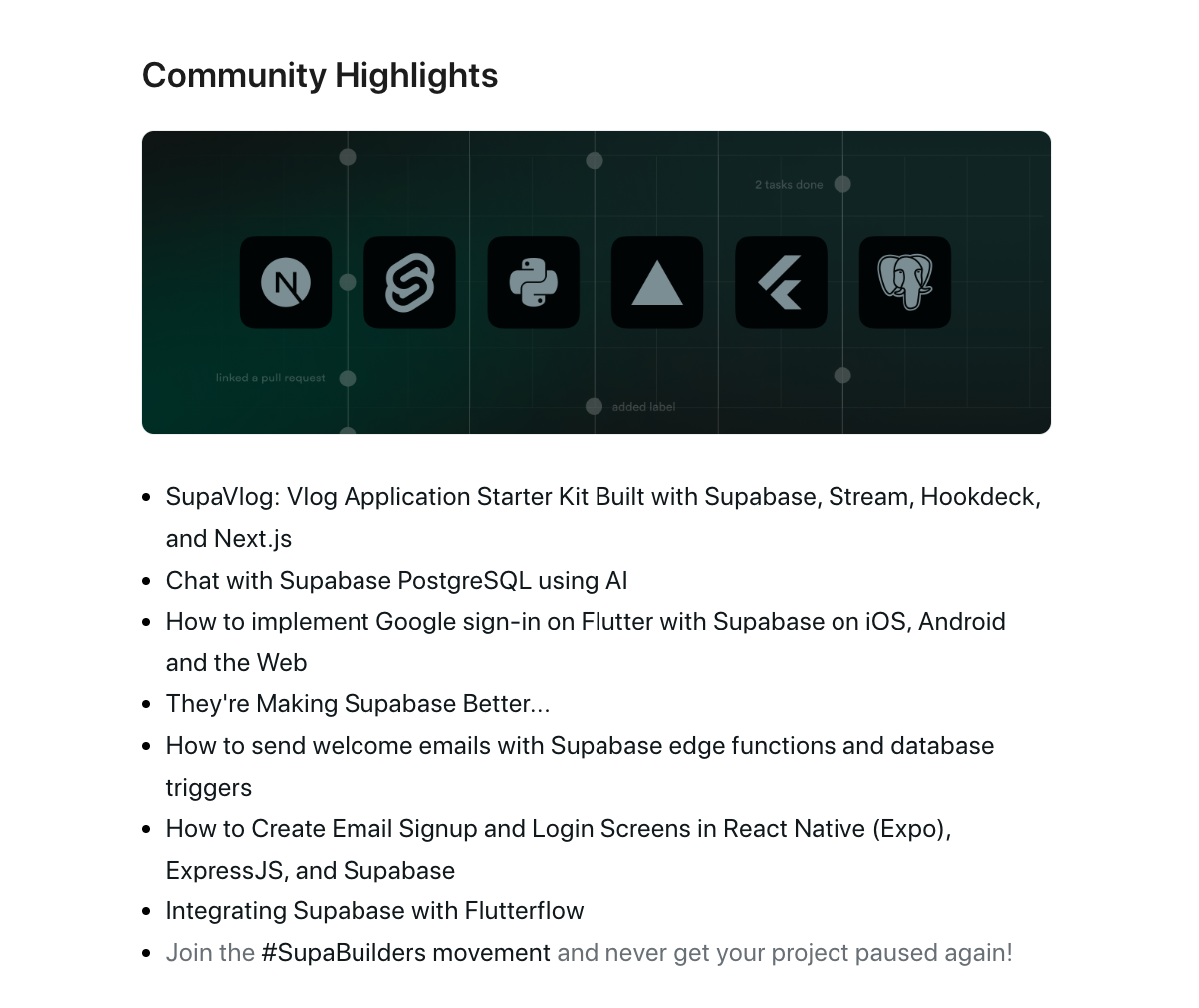
Stytch shares different ways to get in touch with them, including their Slack community:

Product updates: your safest bet
Product updates are the most innocent and value-based way of getting in touch with your audience (without feeling like a salesperson). You’re not selling your product, you’re selling the value of a particular feature.
New feature announcements
Bigger features warrant a dedicated feature announcement email. Moreover, brands like Supabase or Timescale are known for their “launch weeks” — or even months!
Here’s an email from Netlify talking about their blobs feature. See how they’re using a cute illustration as a banner:
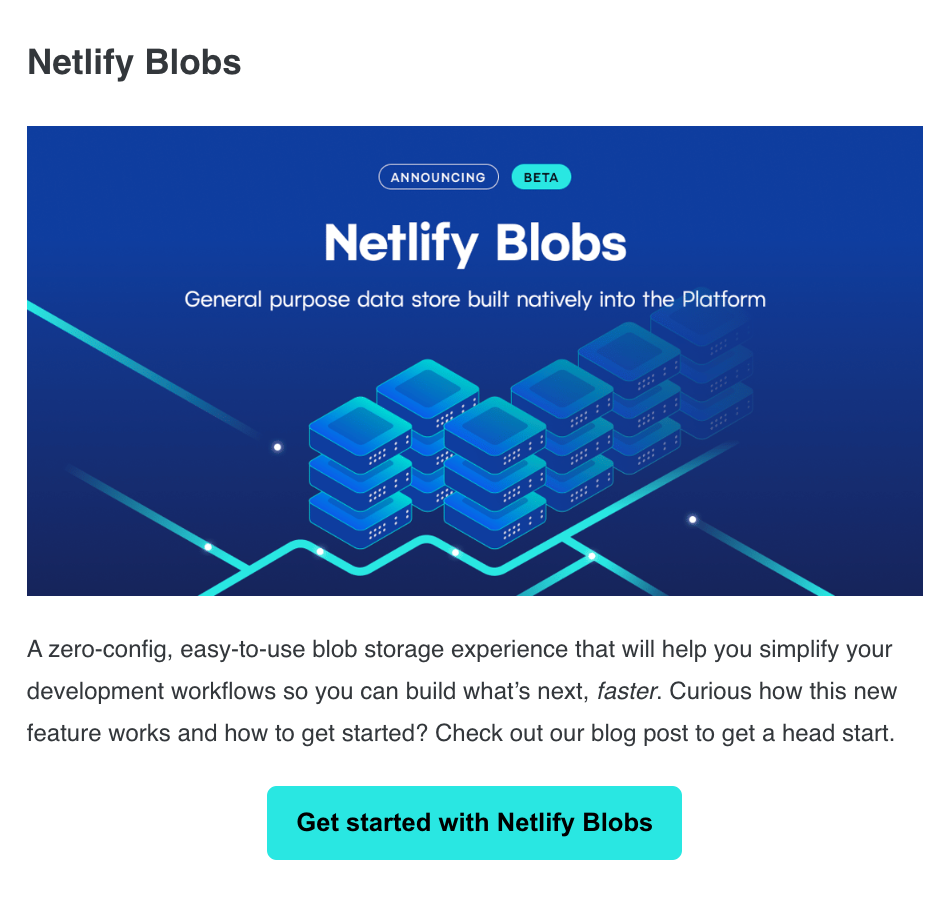
Integrations
Integrations are a special breed of feature updates. They carry special value in the developer world.
Here’s Vercel showcasing a list of their recent AI integrations:
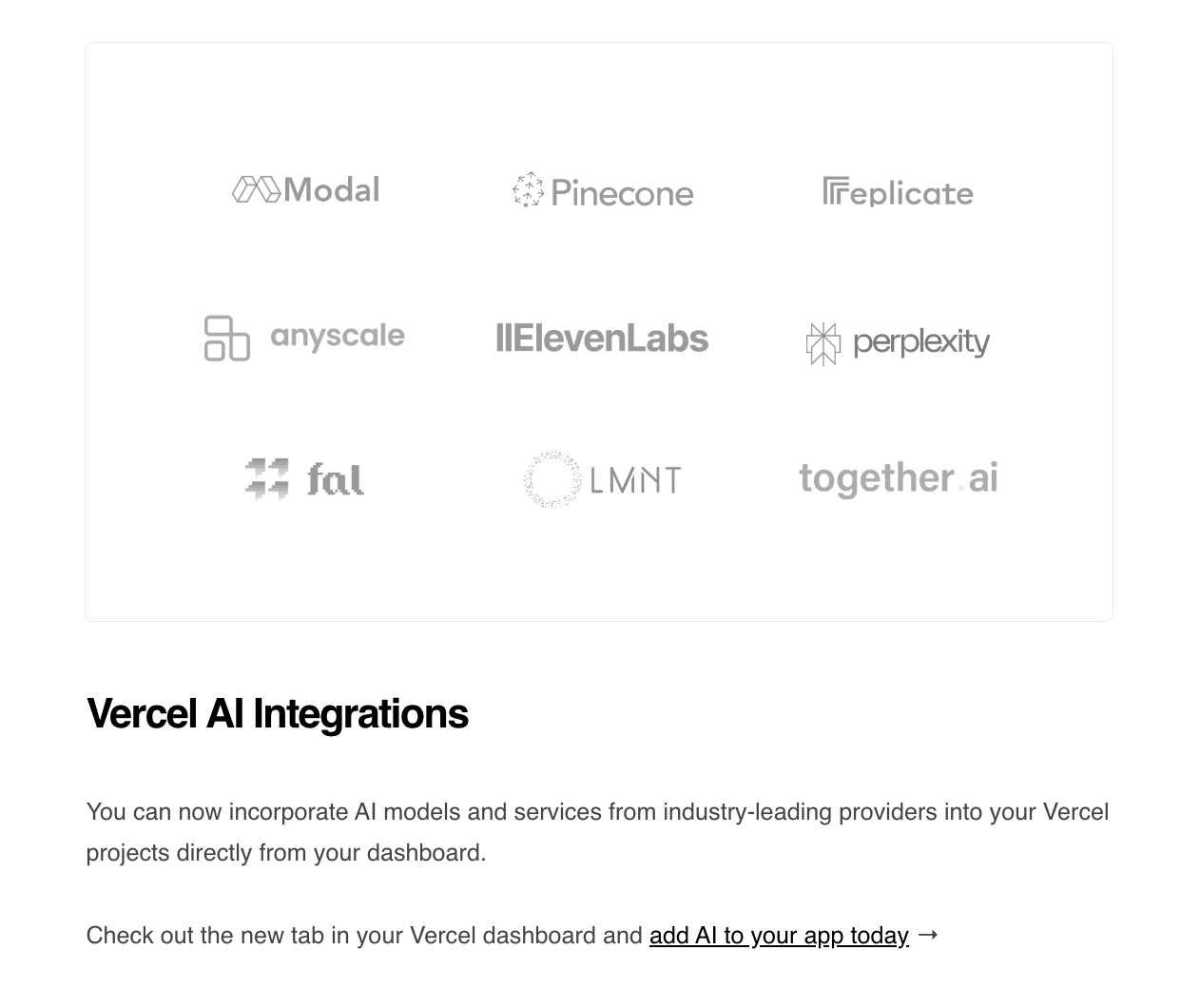
Changelog
It’s common to promote one big feature, and then include changelog notes at the end of the same email.
Here’s a changelog section from Netlify:
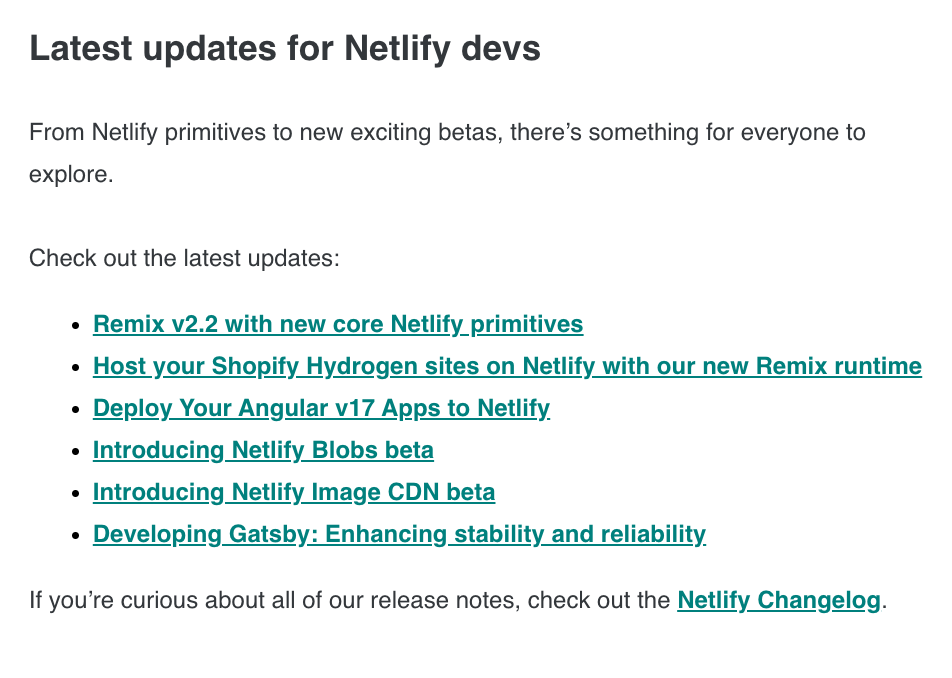
And a changelog section from Vercel:
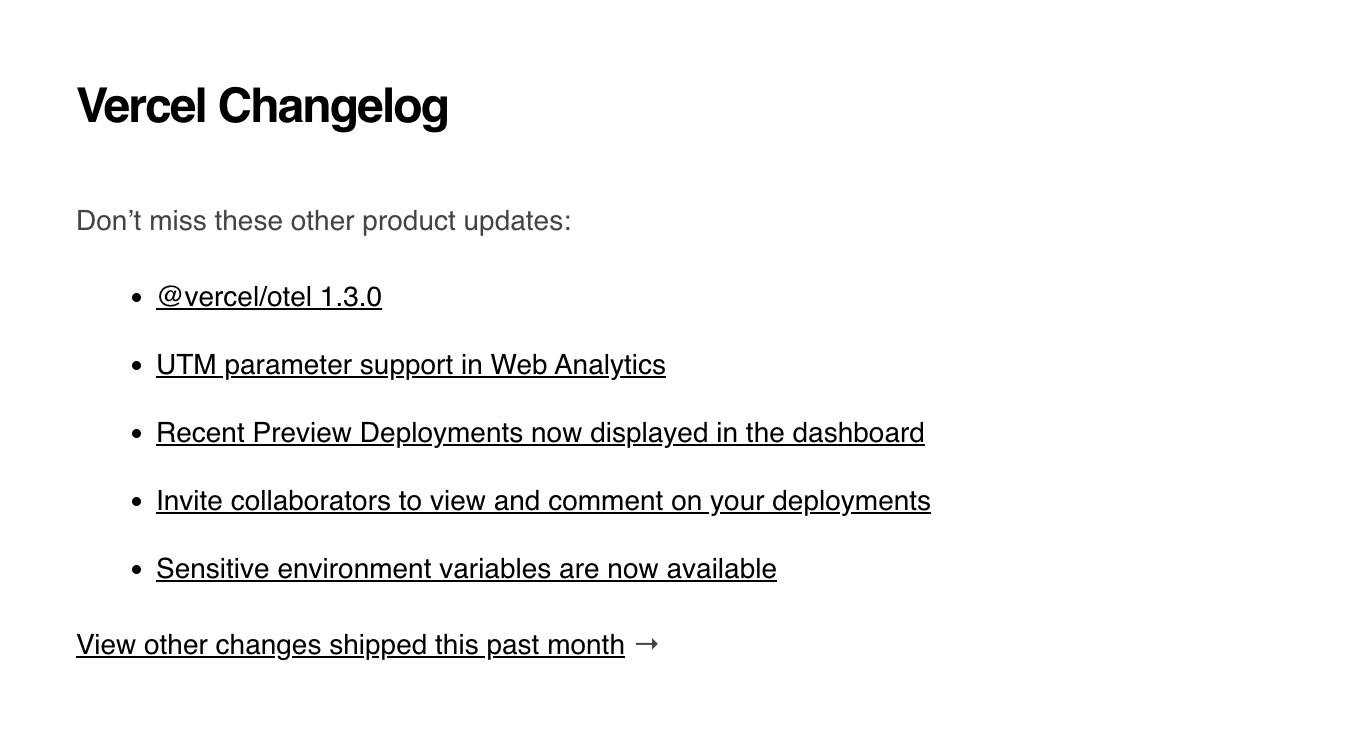
What types of lifecycle emails can you send?
Now let’s walk through the most popular lifecycle situations when you can get in touch with your users.
Welcome email
Even companies with no email marketing still send a welcome email. This is your way to greet users, give them context about your product, and help them take the first steps.
Linear’s welcome email is a classic, well-rounded example.
Subject: Welcome to Linear
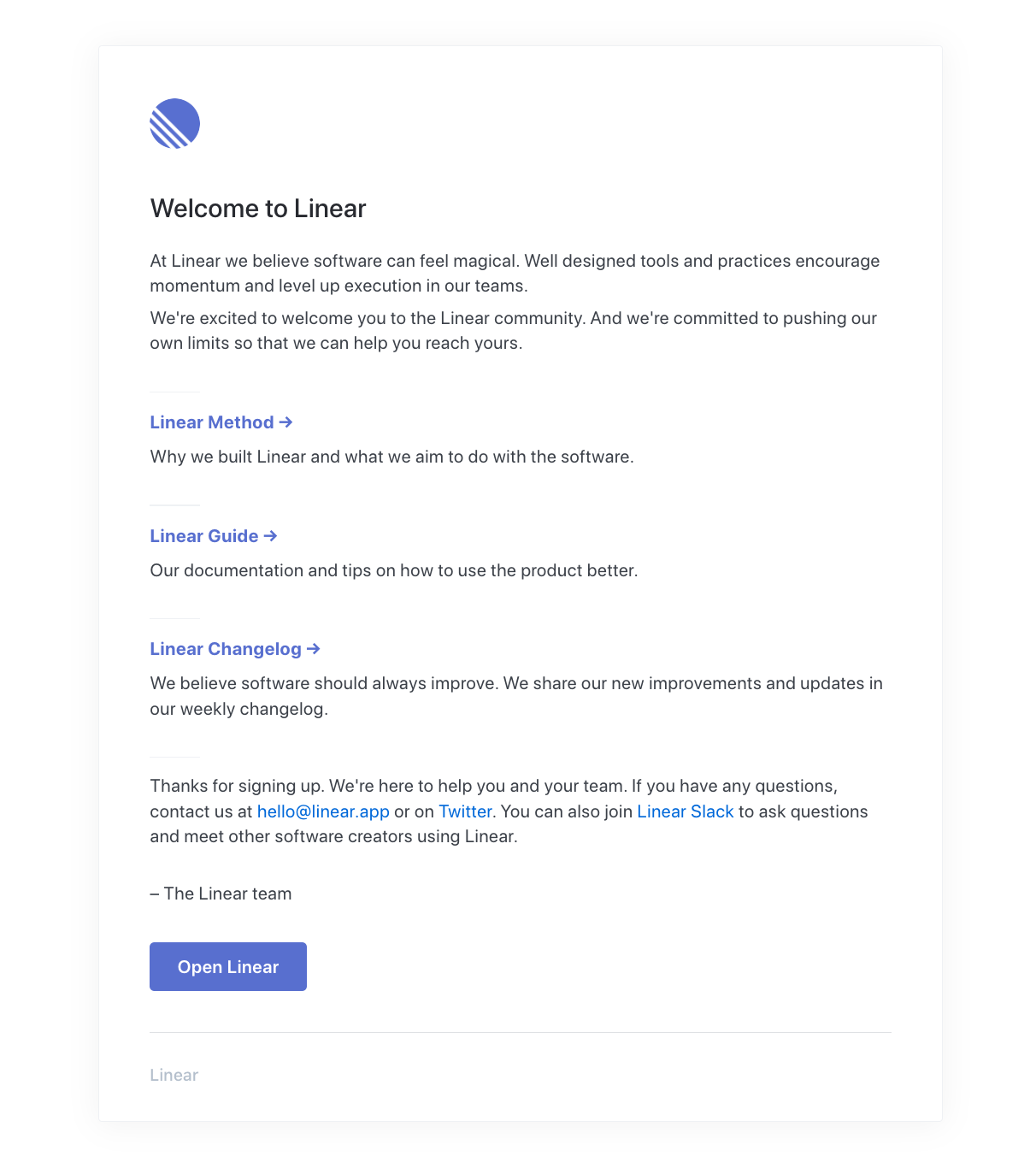
AppSignal sends a minimalist first email with a few helpful links:
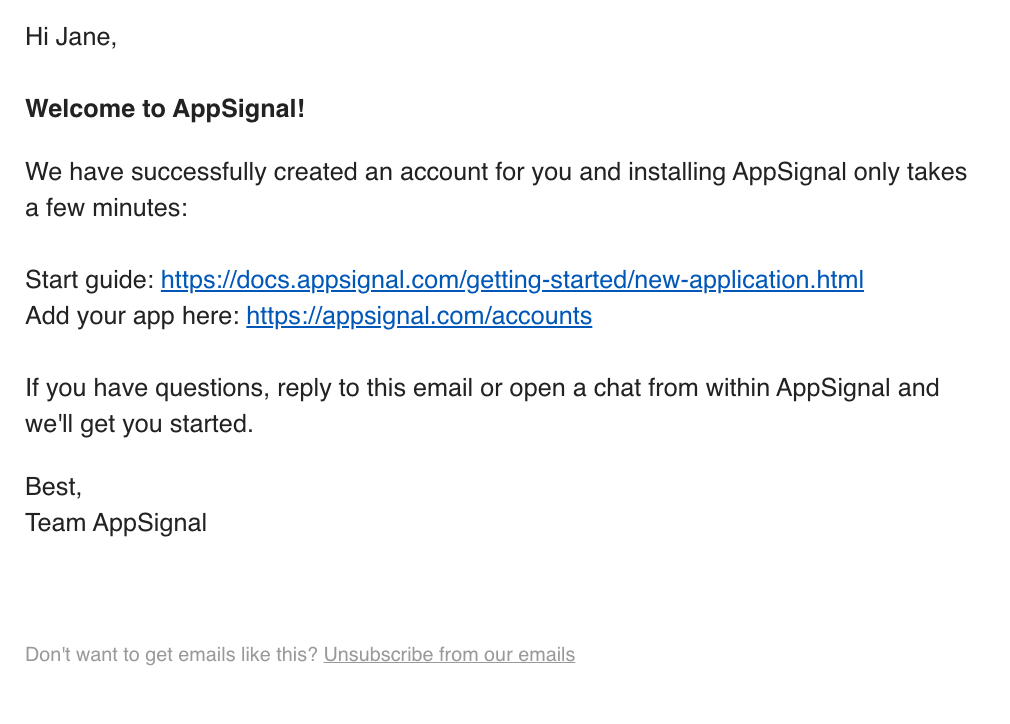
Supabase’s first email is also on the leaner side.
Subject: Welcome to Supabase
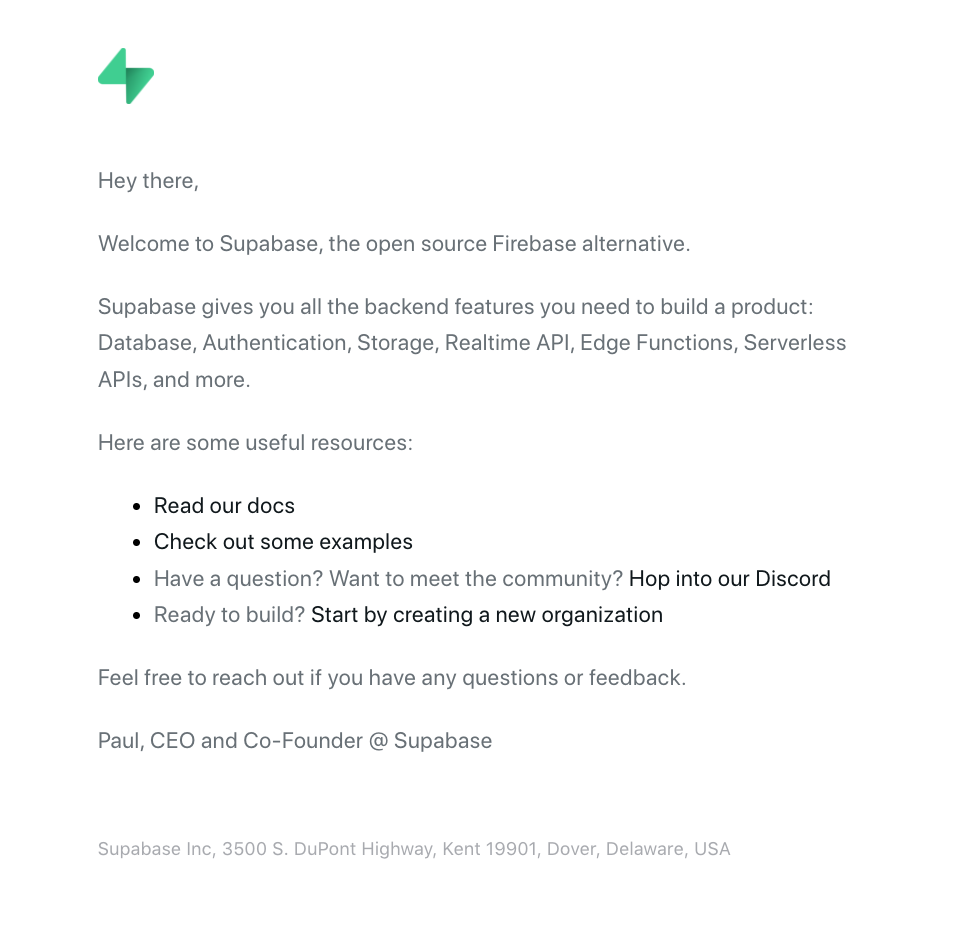
Upgrade to paid
In the freemium model — a #1 choice for devtools — your biggest financial ROI is in converting free users into paying customers. You can do this with a good upgrade email.
Here’s how Vercel offers their free users to try a Pro plan.
Subject: Your personal Vercel account
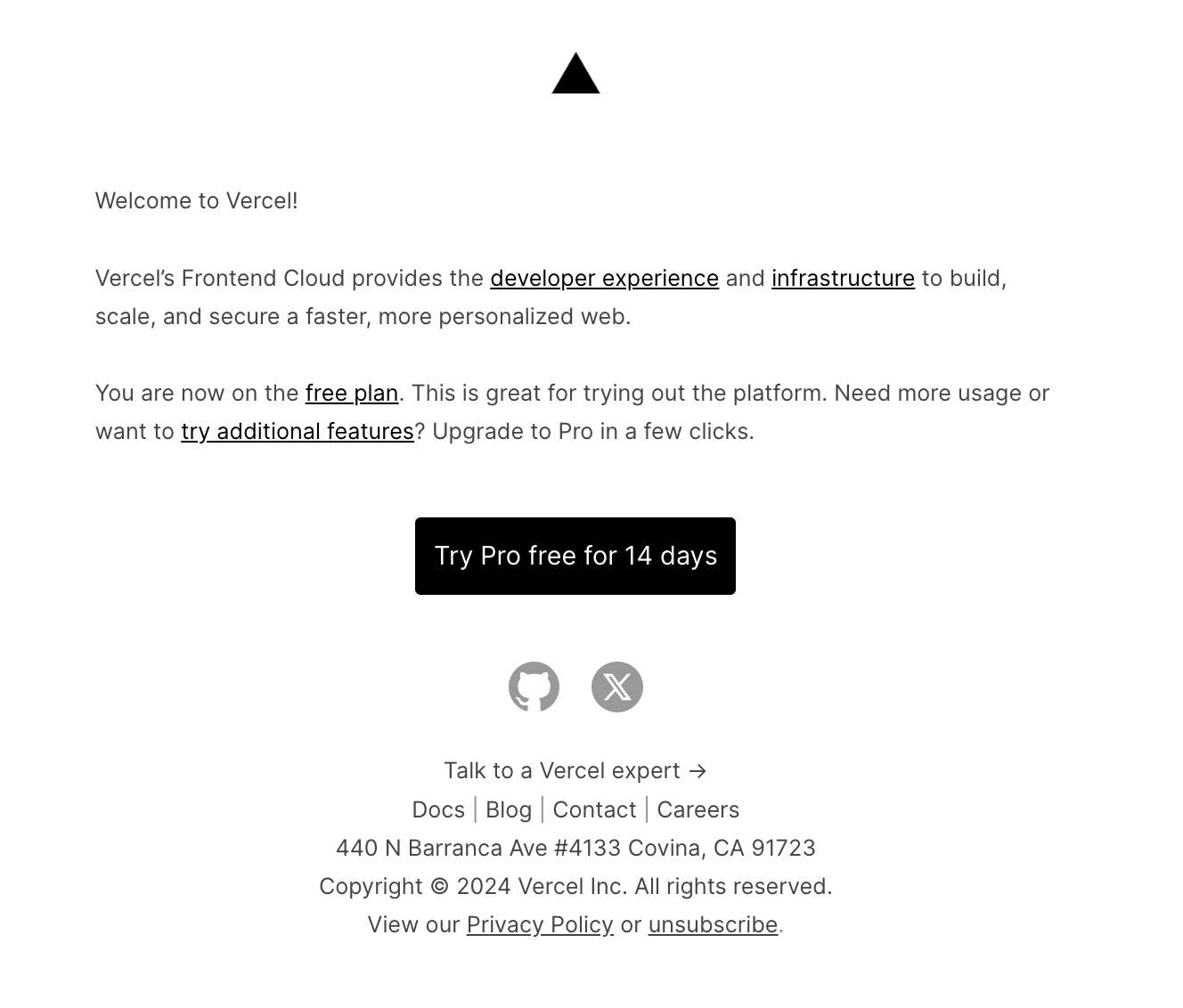
Or here’s another example.
The AppSignal team is asking their customer to upgrade to a higher paid plan based on usage. Note how they’re including specific numbers to support the request.
Subject line: Time for a bigger plan: an upgrade is due for the [company name] organization
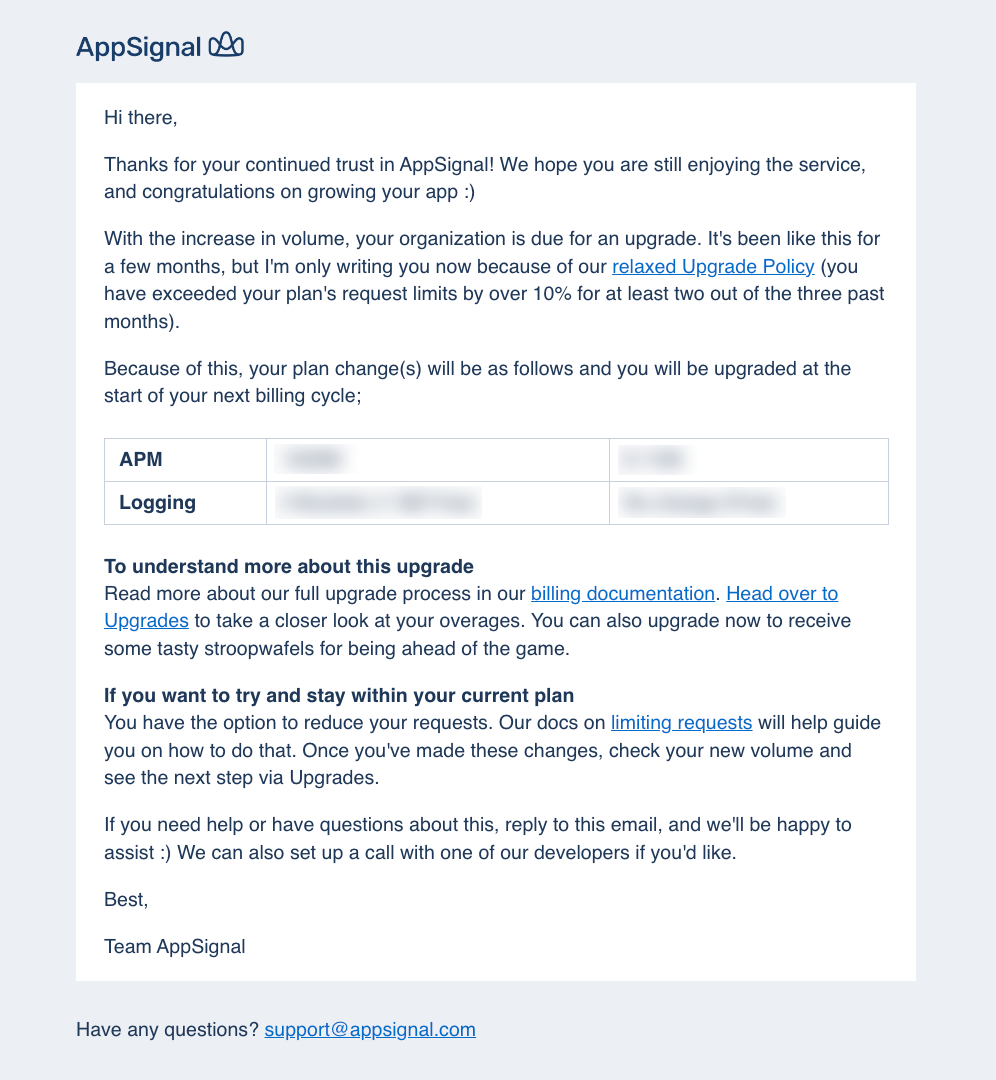
Ask for feedback
When it’s time to collect user feedback, email is your best friend. You can either send a dedicated broadcast to a certain segment of users, or include feedback request emails into your evergreen lifecycle campaigns.
Here’s how PlanetScale asks their users for feedback.
Subject: PlanetScale feedback?

Account reactivation
Reactivation (re-engagement) emails are perfect for recovering inactive accounts. For devtools, it’s a great reason to contact your users and give them a heads-up that their account can be snoozed or deactivated.
Supabase sends this short email to everyone who has been inactive for more than 7 days — which is not a lot of time! They’re not waiting for the account to go too cold.
Subject: Your Supabase Instance
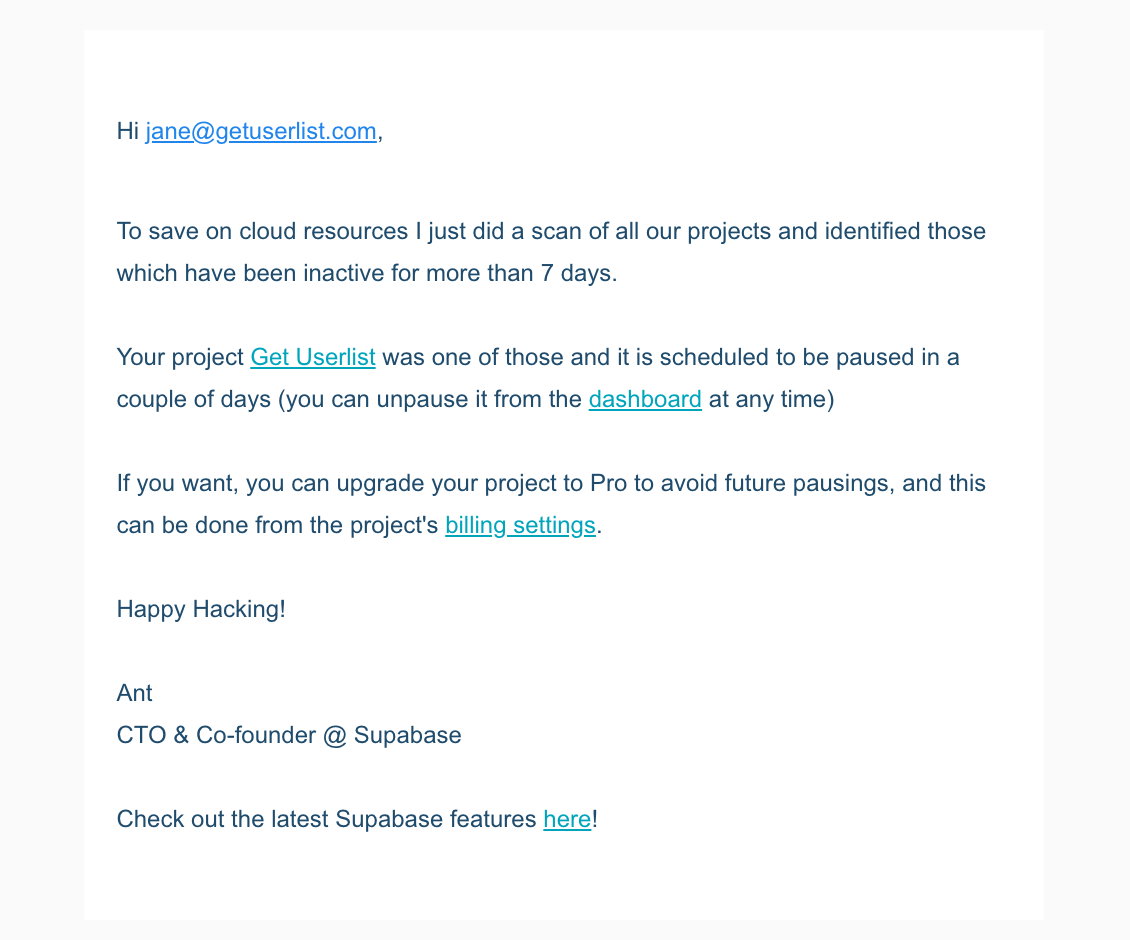
Sunsetting features
Sometimes you’ll be sunsetting features (or even entire products), and you should let your users know.
Here’s how Netlify closed down their asset optimization feature in 2023.
Subject: Deprecation of Post-Processing Asset Optimization
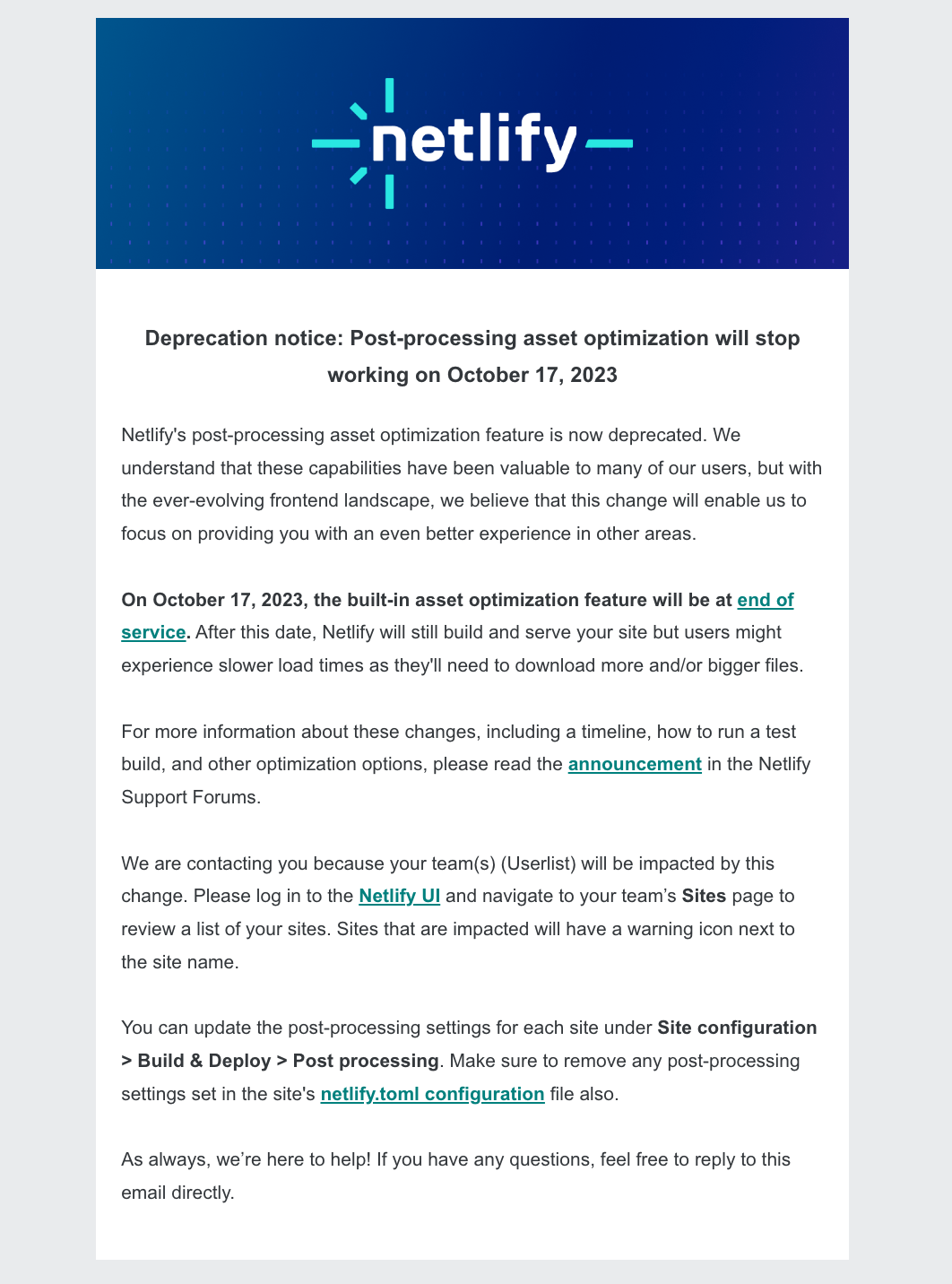
Usage reports
These emails are transactional notifications by nature — hence innocent and not sales-y — but you can use them strategically to remind users about your product and upsell them to higher plans.
Here’s an example notification from GitHub.
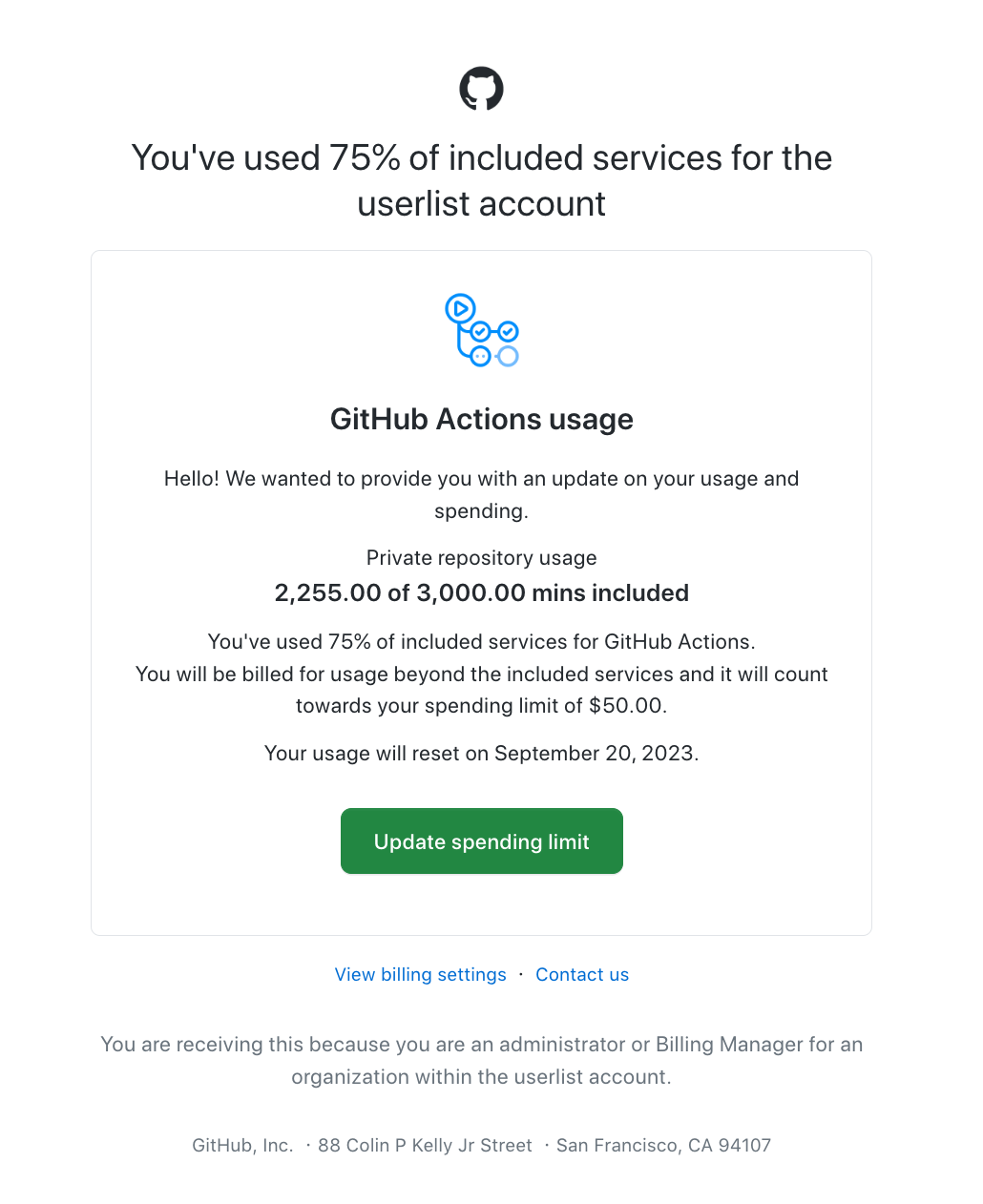
Account reports
You can provide additional value by analyzing user data and creating reports about it. Think about this as “quarterly business reviews on autopilot.”
In the example below, DNSimple offers their customers a CSV report with optimization advice.
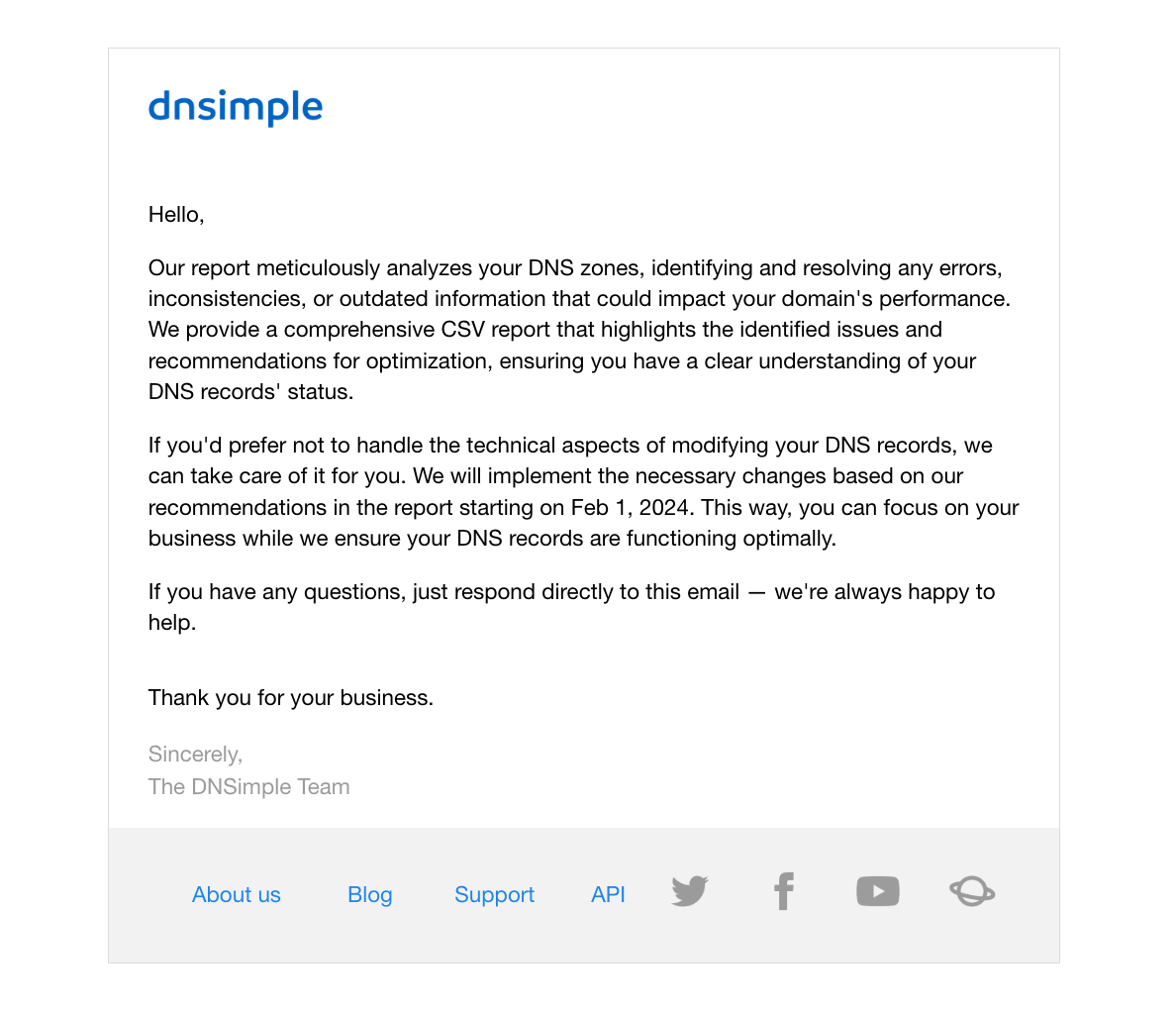
Cancellation emails
Sure, cancellation emails are not a silver bullet, but you can use them to collect feedback and leave a positive aftertaste.
Here’s a short-n-sweet cancellation email from Encrypt.me.
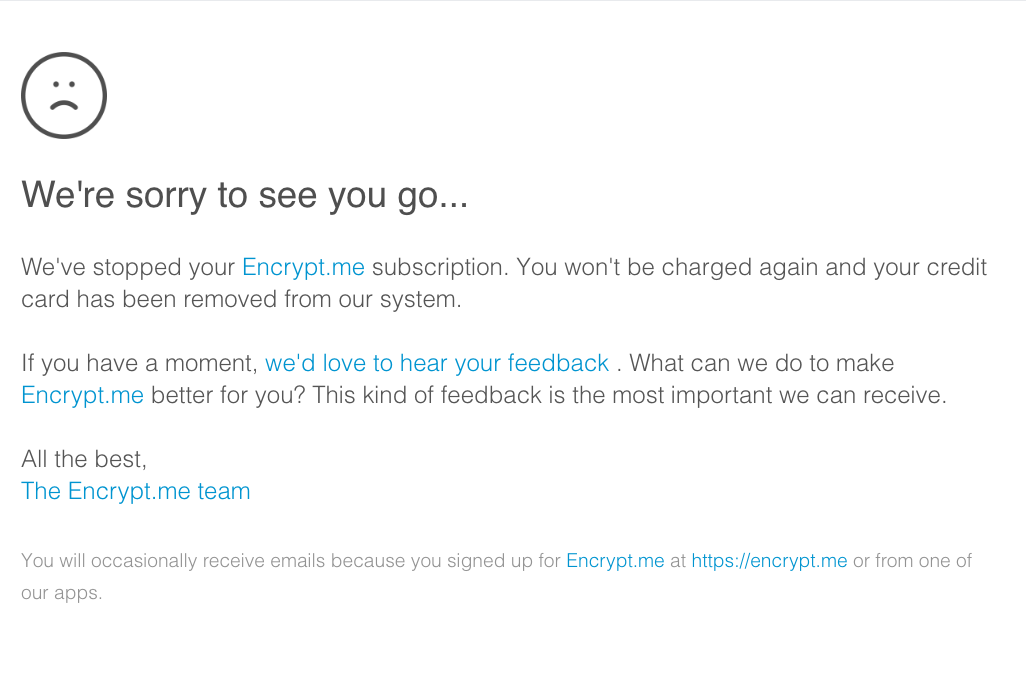
Pricing update
Pricing update emails are loaded with potential — user emotions can sway into good or bad easily. So you should be careful when writing such emails.
Here’s how Netlify announced their plan changes.
Subject: Changes to your Netlify Plan coming in 7 days
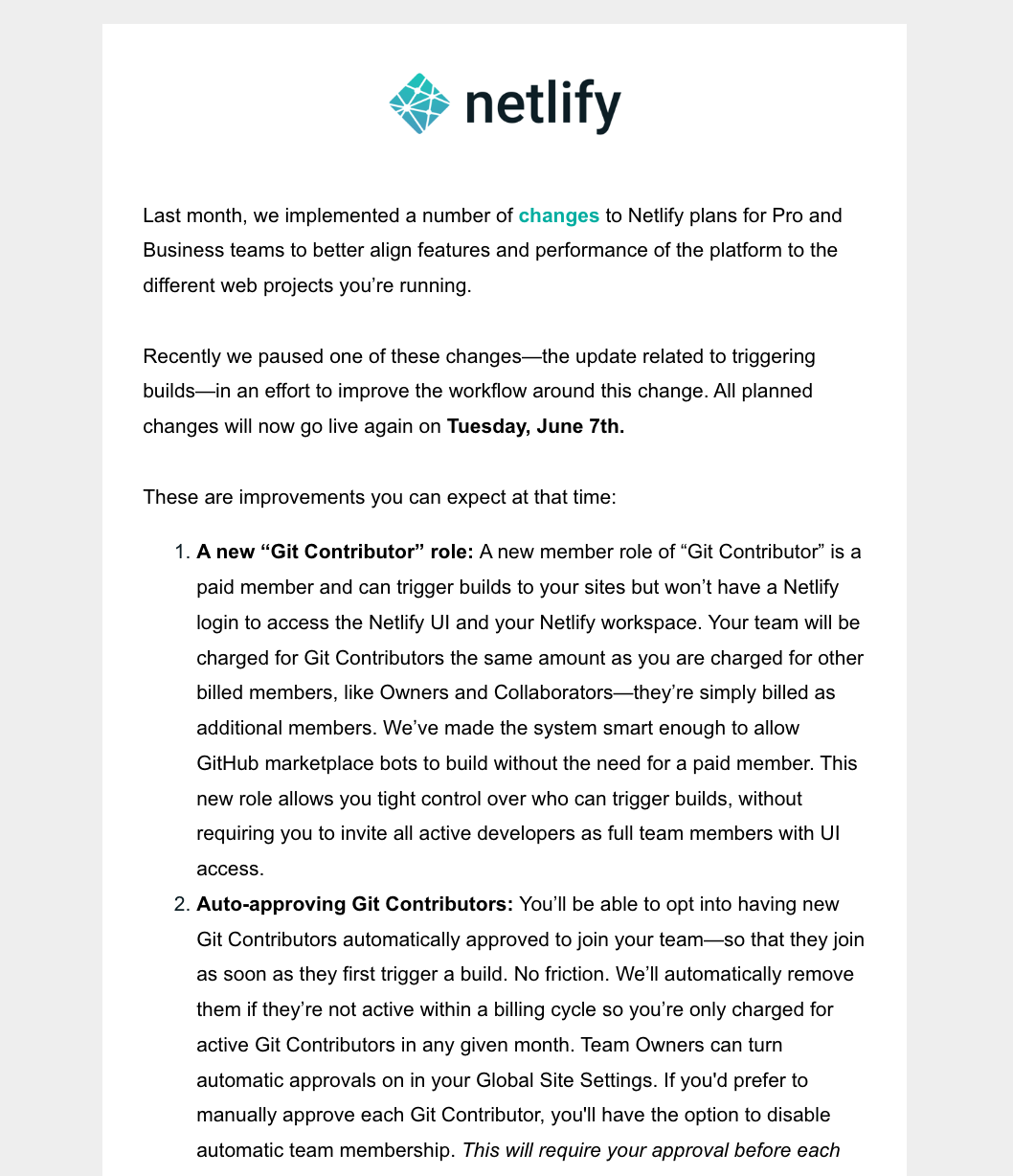
Let’s do this together
Summing this up, email marketing for devtools is a green pasture. Only a handful of brands are doing this at full swing.
Looking for the right tool? Userlist is here to help. Book a demo call and let’s get things going 💛
For further reading, check out these guides:
- SaaS Email Marketing Strategy: Everything You Need to Know
- One Email List, Multiple Products: How to Orchestrate Your Campaigns
- How to Save Money on High Volume Email
Or you can explore our email examples library to find the best SaaS emails for any occasion.
Don’t miss out on new articles. Subscribe to our newsletter and get your monthly dose of SaaS email marketing insights.






